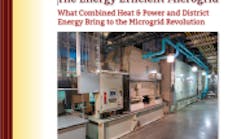This Special Report from Microgrid Knowledge paints a picture of the emerging microgrid-driven world. It also explains topics like district energy and combined heat and power (CHP). You’ll learn how a CHP microgrid improves the economics and energy efficiency of a microgrid.
Local energy promises lower costs, more reliable electric supply, storm resiliency, reduced pollution, greater efficiency, community economic development and jobs, and less forfeiture of open space, habitat and aesthetics to big power plants and transmission lines. Local energy gives communities and businesses the ability to determine their energy future, rather than rely on large, distant corporations, sometimes operated by companies in other states or even countries.
Microgrids are central to this move toward local energy in the United States and Canada. Although they’ve been around for a century, microgrids are particularly attractive in their contemporary form because they bring updated technology and extraordinary intelligence to energy management. These mini versions of the larger grid also are highly energy efficient, particularly when they employ a form of distributed energy known as combined heat and power (CHP).
In addition to CHP, this guide focuses on a closely allied technology, district energy (DE). These systems, too, are big part of the emerging microgrid story. District energy offers tremendous energy and environmental advantage.
Learn why CHP Microgrids are often the most efficient microgrid solution.
